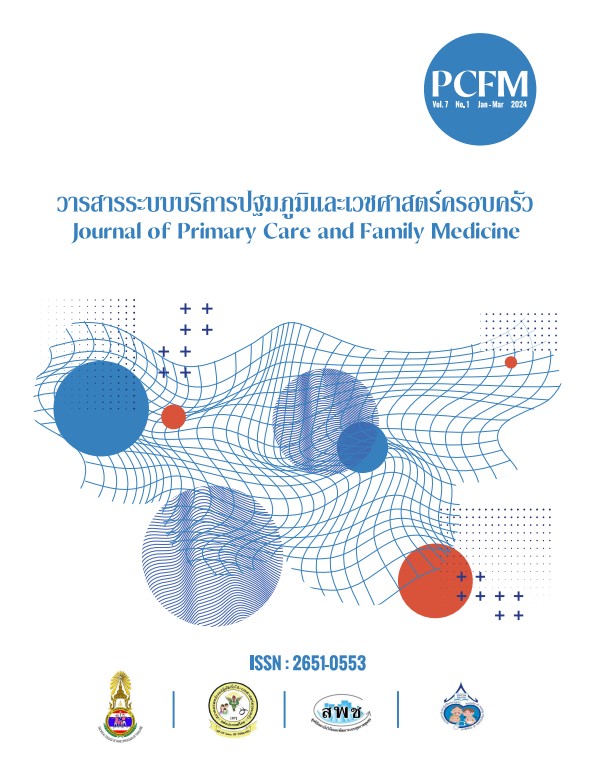ความรู้ ทัศนคติและการรับรู้ของคนไทยต่อวัคซีนป้องกันโรคโควิด 19
Main Article Content
บทคัดย่อ
ที่มาและวัตถุประสงค์: ปัจจุบันวัคซีนโควิด 19 หลายชนิดได้รับการพัฒนาและผลิตสำเร็จ ทั้งนี้ในการดำเนินกลยุทธ์การฉีดวัคซีนที่มีประสิทธิภาพ จำเป็นต้องทราบถึงความรู้ ทัศนคติ และการรับรู้ของคนไทยต่อวัคซีนโควิด 19
แบบวิจัย: การศึกษาเป็นแบบภาพตัดขวาง เชิงปริมานและพรรณนา
วัสดุและวิธีการ: เก็บข้อมูลโดยใช้แบบสอบถามออนไลน์ ช่วง 3 กรกฎาคม- 7 สิงหาคม 2564 มีผู้ตอบแบบสอบถาม 893 ราย
ผลการศึกษา: คะแนนความรู้ มีค่าเฉลี่ย 2.8 คะแนน (±SD 1.1) จาก 5 คะแนน คะแนนทัศนคติ มีค่าเฉลี่ย 10.2 คะแนน (±SD 1.8) จาก 12 คะแนน คำถามที่ไม่เห็นด้วยหรือไม่แน่ใจมากที่สุด (65.5%) คือ “วัคซีนป้องกันโรคโควิด 19 ที่เพิ่งผลิตมีความปลอดภัย” เหตุผลที่ลังเลในการฉีดวัคซีนมากที่สุด 3 ลำดับแรก ได้แก่ 1) ไม่แน่ใจเรื่องผลข้างเคียง (34.8%) 2) ไม่แน่ใจเรื่องประสิทธิภาพหรือคุณภาพของวัคซีน (34.3%) 3) ไม่แน่ใจยี่ห้อ เทคโนโลยีที่ผลิต หรือต้องการฉีดวัคซีนอื่น เช่น mRNA (24.0%) ด้านการรับรู้ส่วนใหญ่คิดว่าวัคซีนอาจมีผลข้างเคียง (90.8%) ควรได้รับการจัดสรรโดยไม่มีค่าใช้จ่าย (98.2%) ทุกคนสมควรได้รับวัคซีน (88.9%) และบุคลากรทางการแพทย์ควรได้รับวัคซีนเป็นลำดับแรก (91.2%)
สรุป: คะแนนเฉลี่ยความรู้ของกลุ่มตัวอย่างมีระดับปานกลาง แต่คะแนนด้านทัศนคติเป็นไปในทางบวก ทั้งนี้ควรมีการเผยแพร่ข้อมูลด้านประสิทธิภาพและความปลอดภัยของวัคซีนให้มากขึ้น
Article Details

อนุญาตภายใต้เงื่อนไข Creative Commons Attribution-NonCommercial-NoDerivatives 4.0 International License.
เนื้อหาและข้อมูลในบทความที่ลงตีพิมพ์ในวารสาร PCFM ถือเป็นข้อคิดเห็นและความรับผิดชอบของผู้เขียนบทความโดยตรง ซึ่งกองบรรณาธิการวารสารไม่จำเป็นต้องเห็นด้วยหรือร่วมรับผิดชอบใด ๆ
บทความ ข้อมูล เนื้อหา รูปภาพ ฯลฯ ที่ได้รับการตีพิมพ์ลงในวารสาร PCFM ถือเป็นลิขสิทธิ์ของวารสาร PCFM หากบุคคลหรือหน่วยงานใดต้องการนำทั้งหมดหรือส่วนหนึ่งส่วนใดไปเผยแพร่ต่อหรือเพื่อกระทำการใด ๆ จะต้องได้รับอนุญาตเป็นลายลักษณ์อักษรจากวารสาร PCFM ก่อนเท่านั้น
เอกสารอ้างอิง
World Health Organization (WHO). Naming the coronavirus disease (COVID-19) and the virus that causes it. [internet]. 2020[cited 9 March 2020]. Available from: https://www.who.int/emergencies/diseases/novel-coronavirus-2019.
Wu JT, Leung K, Leung GM. Nowcasting and forecasting the potential domestic and international spread of the 2019-nCoV outbreak originating in Wuhan, China: a modelling study. Lancet. 2020;395(10225):689-97.
กรมควบคุมโรค กระทรวงสาธารณสุข. โรคติดเชื้อไวรัสโคโรนา 2019 (COVID-19). [internet]. 2563 [เข้าถึงเมื่อ 10 เมย 2563]. เข้าถึงได้จาก: https://ddc.moph.go.th/viralpneumonia/
World Health Organization (WHO). Coronavirus disease (COVID-19) dashboard 2021 [internet]. 2021 [cited 17 Apr 2021]. Available from: https://covid19.who.int.
Center for Disease Control and Prevention (CDC). Ways COVID-19 Spreads. [internet] 2020[cited 14 Apr 2021]. Available from htttp://www.cdc.gov/coronavirus/2019-ncov/science/science-agenda-covid19.html
Rahman HS, Aziz MS, Hussein RH, Othman HH, Salih Omer SH, Khalid ES, et al. The transmission modes and sources of COVID-19: A systematic review. International Journal of Surgery Open. 2020;26:125-36.
Liu J, Liao X, Qian S, Yuan J, Wang F, Liu Y, et al. Community Transmission of Severe Acute Respiratory Syndrome Coronavirus 2, Shenzhen, China, 2020. Emerg Infect Dis. 2020;26(6):1320-3.
Li X, Luk HKH, Lau SKP, Woo PCY. Human Coronaviruses: General Features. Reference Module in Biomedical Sciences: Elsevier; 2019.
Park S. Epidemiology, virology, and clinical features of severe acute respiratory syndrome-coronavirus-2 (SARS-COV-2; Coronavirus Disease-19). Clinical and Experimental Pediatrics. 2020;63.
Wang Y, Tian H, Zhang L, Zhang M, Guo D, Wu W, et al. Reduction of secondary transmission of SARS-CoV-2 in households by face mask use, disinfection and social distancing: a cohort study in Beijing, China. BMJ Glob Health. 2020;5(5).
Talic S, Shah S, Wild H, Gasevic D, Maharaj A, Ademi Z, et al. Effectiveness of public health measures in reducing the incidence of covid-19, SARS-CoV-2 transmission, and covid-19 mortality: systematic review and meta-analysis. Bmj. 2021;375:e068302.
Andrejko KL, Pry JM, Myers JF, Fukui N, DeGuzman JL, Openshaw J, et al. Effectiveness of Face Mask or Respirator Use in Indoor Public Settings for Prevention of SARS-CoV-2 Infection - California, February-December 2021. MMWR Morb Mortal Wkly Rep. 2022;71(6):212-6.
World Health Organization (WHO). Coronavirus disease (COVID-19) Vaccines. [internet]. 2021 [cited 14 Apr 2021]. Available from: https://www.who.int/emergencies/diseases/novel-coronavirus-2019/covid-19-vaccines
Ahn DG, Shin HJ, Kim MH, Lee S, Kim HS, Myoung J, et al. Current Status of Epidemiology, Diagnosis, Therapeutics, and Vaccines for Novel Coronavirus Disease 2019 (COVID-19). J Microbiol Biotechnol. 2020;30(3):313-24.
กรมควบคุมโรค กระทรวงสาธารณสุข. แนวทางการให้วัคซีนโควิด 19 ในสถานการณ์การระบาดปี 64 ของประเทศไทย.[internet]. 2563 [เข้าถึงเมื่อ 16 มีค 2563]. เข้าถึงได้จาก: https://ddc.moph.go.th/vaccine-covid19/
Islam MS, Siddique AB, Akter R, Tasnim R, Sujan MSH, Ward PR, et al. Knowledge, attitudes and perceptions towards COVID-19 vaccinations: a cross-sectional community survey in Bangladesh. medRxiv. 2021:2021.02.16.21251802.
Bhartiya S, Kumar N, Wadhwani M. Knowledge, attitude and practice towards COVID-19 vaccination acceptance in West India. International Journal Of Community Medicine And Public Health. 2021;9:303.
El-Elimat T, AbuAlSamen MM, Almomani BA, Al-Sawalha NA, Alali FQ. Acceptance and Attitudes Toward COVID-19 Vaccines: A Cross-Sectional Study from Jordan. medRxiv. 2020:2020.12.22.20248676.
Di Gennaro F, Murri R, Segala FV, Cerruti L, Abdulle A, Saracino A, et al. Attitudes towards Anti-SARS-CoV2 Vaccination among Healthcare Workers: Results from a National Survey in Italy. Viruses. 2021;13(3).
กรมควบคุมโรค และโครงการประเมินเทคโนโลยีและนโยบายด้านสุขภาพ Health Intervention and Technology Assesment Program HITAP. ผลสำรวจความเห็นของบุคลากรทางการแพทย์และสาธารณสุขต่อการรับวัคซีนโควิด-19ในประเทศไทย.[internet]. 2564.[เข้าถึงเมื่อ 10 เมษ 2564] เข้าถึงได้จาก: https://www.hitap.net/wp-content/uploads/2021/03/PB_Covid-Vaccine-Demand-Web.pdf


